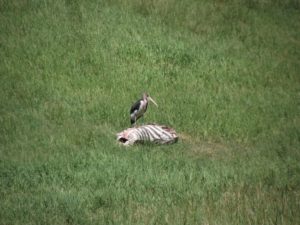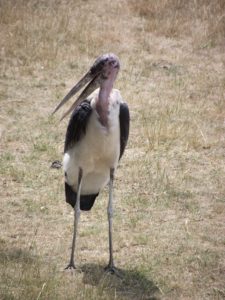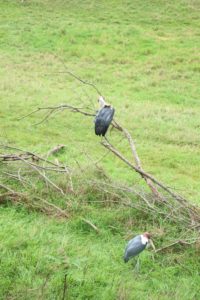MARABOU STORKLeptoptilos crumeniferus
Conservation Status: Low Risk / Least Concern
Due to its trophic strategy, the number of these birds is actually increasing.

Learn More
Color:
This bird is characterized by a balding pink head, a large wedge-shaped bill, and greyish blue wings that can span almost 3 meters. When walking, it is hunched over and balances on long legs. There is a fleshy, inflatable pink waddle below its bill. The neck is pink and nearly featherless, but has a white feather collar around the base of its neck. The belly and feathers underneath are white.
Size:
1.5 meters tall
Weight:
8.9 kg
Average Lifespan:
25 years
Captive Lifespan:
41 years
Sub-Saharan Africa
The marabou stork inhabits savannas, swamps, and can be seen around rivers and lakes. They can be found close by to humans in areas such as dumps, slaughterhouses, and fishing areas.
Mating:
They gather to breed during the dry season, in groups from 20 to thousands of birds. Males will inflate their throat pouches.
Gestation/Incubation:
The eggs will be incubated for about a month
Litter/Clutch Size:
2-3 eggs
Mature:
They reach sexual maturity at 4 years old
It may hunt some prey such as lizards, frogs, snakes, rodents, and birds, but it is mainly a carrion feeder.
The marabou stork behaves more like a vulture than a stork, and is considered a scavenger. They can be found in groups of up to 1000 individuals. This bird is diurnal. They fly with the neck curved back in an S shape to allow the shoulders to support the weight of the heavy beak.
1. Their legs may appear white due to a buildup of excrement on them. This allows them to cool off and also has some antiseptic properties.
2. They will nest in trees and their nests are made of sticks.
3. Since they eat carrion, these birds help to prevent the spread of disease.
4. They may clack their beaks if they feel threatened or prior to mating.







